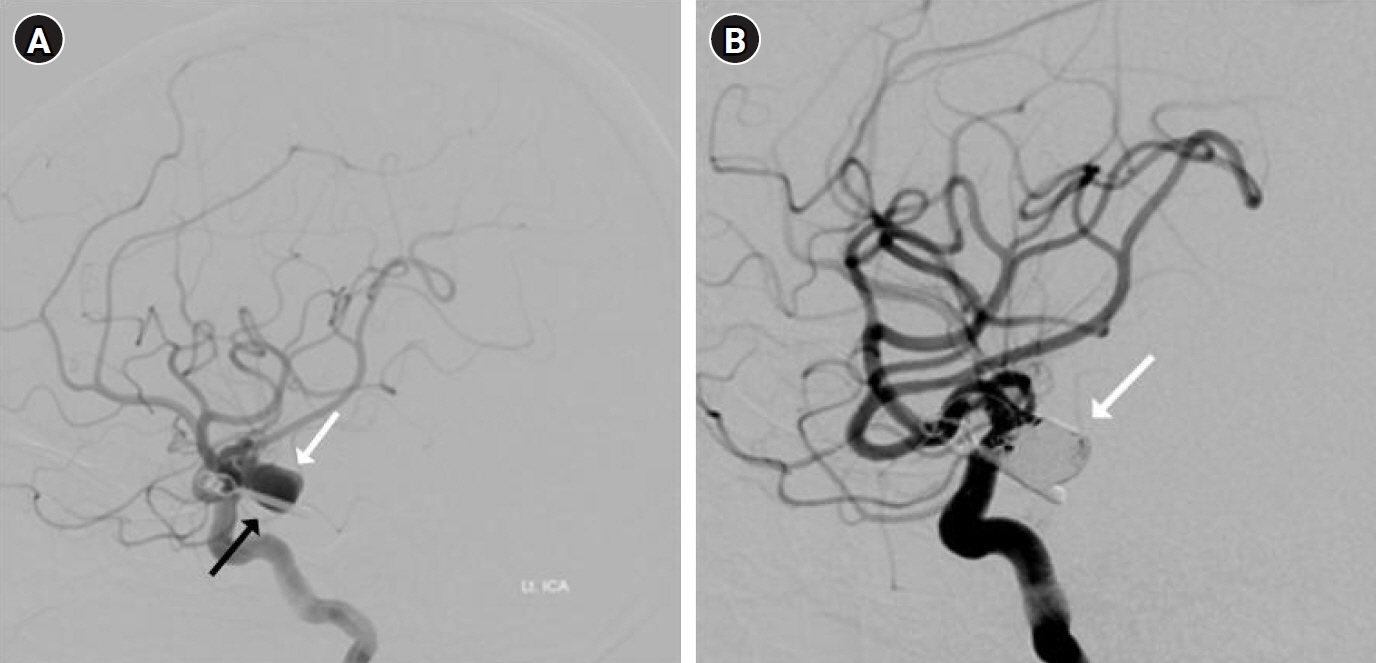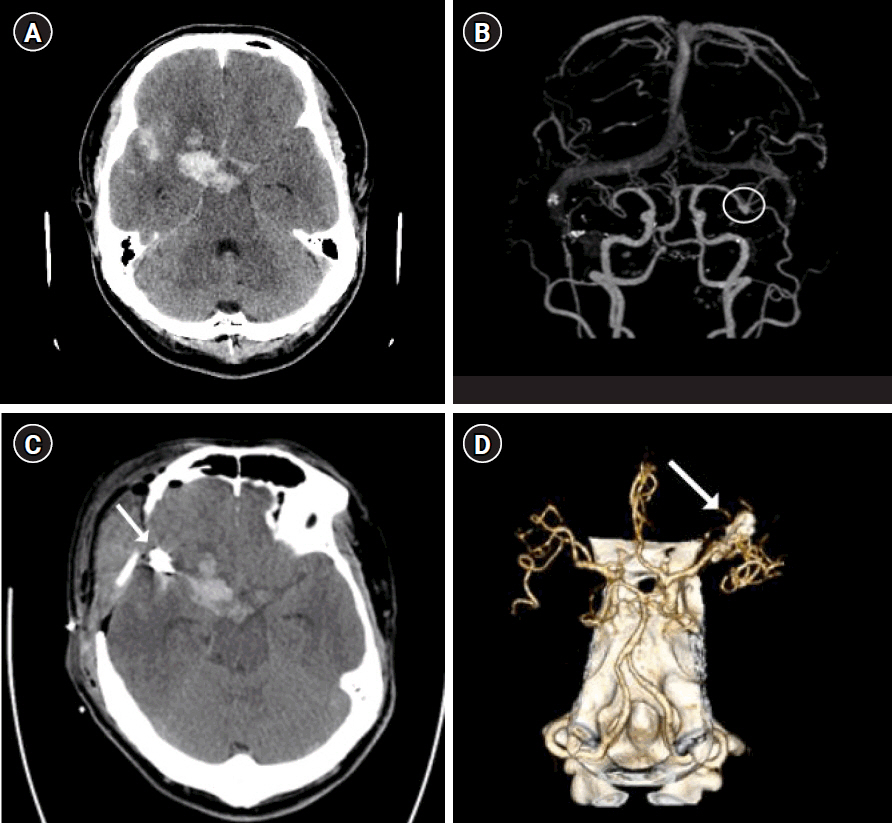Kosin Med J.
2024 Dec;39(4):281-289. 10.7180/kmj.24.138.
Intracranial aneurysms in autosomal dominant polycystic kidney disease
- Affiliations
-
- 1Department of Neurosurgery, Kosin University Gospel Hospital, Kosin University College of Medicine, Busan, Korea
- KMID: 2562812
- DOI: http://doi.org/10.7180/kmj.24.138
Abstract
- Background
The incidence of intracranial aneurysms (ICA) is high in patients with autosomal dominant polycystic kidney disease (ADPKD). However, little is known regarding the optimal screening and treatment methods for ICA.
Methods
This study investigated the characteristics of ADPKD patients with ICA, analyzing each variable according to whether the ICA ruptured, and examined the outcomes according to the treatment method. Specifically, a retrospective study was conducted on the treatment of ICA patients with ADPKD at a single institution for 10 years, from 2013 to 2022.
Results
The mean age of the 17 enrolled ADPKD patients with ICA was 57.4 years. Surgical and endovascular treatment methods were used in four and 13 patients. Eleven patients had unruptured ICAs, and the remaining six patients had suffered subarachnoid hemorrhage (SAH). Two patients experienced neurological deficits after discharge. All patients with unruptured ICAs were discharged without any complications, although one of them underwent additional treatment 5 years later. Four patients with SAH had known ADPKD at the time of diagnosis (67%). As for the treatment method, 13 patients were treated with coiling. In a comparison of variables between unruptured ICA and SAH patients, the location of the ICA showed a statistically significant difference (p<0.05).
Conclusions
In ADPKD patients, diagnostic screening for the detection of ICA is essential, and with appropriate management, interventional endovascular treatment may be a good treatment option.
Figure
Reference
-
References
1. Gieteling EW, Rinkel GJ. Characteristics of intracranial aneurysms and subarachnoid haemorrhage in patients with polycystic kidney disease. J Neurol. 2003; 250:418–23.
Article2. Torres VE, Harris PC, Pirson Y. Autosomal dominant polycystic kidney disease. Lancet. 2007; 369:1287–301.
Article3. Xu HW, Yu SQ, Mei CL, Li MH. Screening for intracranial aneurysm in 355 patients with autosomal-dominant polycystic kidney disease. Stroke. 2011; 42:204–6.
Article4. Rinkel GJ. Intracranial aneurysm screening: indications and advice for practice. Lancet Neurol. 2005; 4:122–8.
Article5. Schievink WI, Torres VE, Piepgras DG, Wiebers DO. Saccular intracranial aneurysms in autosomal dominant polycystic kidney disease. J Am Soc Nephrol. 1992; 3:88–95.
Article6. Zuka M, Onoe T, Kawano M, Yamagishi M, Ohshima T. Sudden death of a young male with previously undiagnosed autosomal dominant polycystic kidney disease (ADPKD). Leg Med (Tokyo). 2011; 13:35–8.
Article7. Thompson BG, Brown RD, Amin-Hanjani S, Broderick JP, Cockroft KM, Connolly ES, et al. Guidelines for the management of patients with unruptured intracranial aneurysms: a guideline for healthcare professionals from the American Heart Association/American Stroke Association. Stroke. 2015; 46:2368–400.
Article8. Chapman AB, Devuyst O, Eckardt KU, Gansevoort RT, Harris T, Horie S, et al. Autosomal-dominant polycystic kidney disease (ADPKD): executive summary from a Kidney Disease: Improving Global Outcomes (KDIGO) controversies conference. Kidney Int. 2015; 88:17–27.
Article9. Butler WE, Barker FG, Crowell RM. Patients with polycystic kidney disease would benefit from routine magnetic resonance angiographic screening for intracerebral aneurysms: a decision analysis. Neurosurgery. 1996; 38:506–16.
Article10. Caranci F, Briganti F, Cirillo L, Leonardi M, Muto M. Epidemiology and genetics of intracranial aneurysms. Eur J Radiol. 2013; 82:1598–605.
Article11. Wiebers DO, Whisnant JP, Huston J, Meissner I, Brown RD, Piepgras DG, et al. Unruptured intracranial aneurysms: natural history, clinical outcome, and risks of surgical and endovascular treatment. Lancet. 2003; 362:103–10.
Article12. Zhou Z, Xu Y, Delcourt C, Shan J, Li Q, Xu J, et al. Is regular screening for intracranial aneurysm necessary in patients with autosomal dominant polycystic kidney disease? A systematic review and meta-analysis. Cerebrovasc Dis. 2017; 44:75–82.
Article13. Cheungpasitporn W, Thongprayoon C, Ungprasert P, Wijarnpreecha K, Kaewput W, Leeaphorn N, et al. Subarachnoid hemorrhage in hospitalized renal transplant recipients with autosomal dominant polycystic kidney disease: a nationwide analysis. J Clin Med. 2019; 8:524.
Article14. Neumann HP, Malinoc A, Bacher J, Nabulsi Z, Ivanovas V, Bruechle NO, et al. Characteristics of intracranial aneurysms in the Else Kröner-Fresenius Registry of autosomal dominant polycystic kidney disease. Cerebrovasc Dis Extra. 2012; 2:71–9.
Article15. Kip SN, Hunter LW, Ren Q, Harris PC, Somlo S, Torres VE, et al. [Ca2+]i reduction increases cellular proliferation and apoptosis in vascular smooth muscle cells: relevance to the ADPKD phenotype. Circ Res. 2005; 96:873–80.16. Qian Q, Hunter LW, Li M, Marin-Padilla M, Prakash YS, Somlo S, et al. Pkd2 haploinsufficiency alters intracellular calcium regulation in vascular smooth muscle cells. Hum Mol Genet. 2003; 12:1875–80.
Article17. Levey AS, Pauker SG, Kassirer JP. Occult intracranial aneurysms in polycystic kidney disease: when is cerebral arteriography indicated? N Engl J Med. 1983; 308:986–94.
Article18. Ong AC. Screening for intracranial aneurysms in ADPKD. BMJ. 2009; 339:b3763.
Article19. Belz MM, Hughes RL, Kaehny WD, Johnson AM, Fick-Brosnahan GM, Earnest MP, et al. Familial clustering of ruptured intracranial aneurysms in autosomal dominant polycystic kidney disease. Am J Kidney Dis. 2001; 38:770–6.
Article20. Brisman JL, Song JK, Newell DW. Cerebral aneurysms. N Engl J Med. 2006; 355:928–39.
Article21. Longstreth WT, Nelson LM, Koepsell TD, van Belle G. Subarachnoid hemorrhage and hormonal factors in women: a population-based case-control study. Ann Intern Med. 1994; 121:168–73.
Article22. Jung SC, Kim CH, Ahn JH, Cho YD, Kang HS, Cho WS, et al. Endovascular treatment of intracranial aneurysms in patients with autosomal dominant polycystic kidney disease. Neurosurgery. 2016; 78:429–35.
Article23. Hunt WE, Hess RM. Surgical risk as related to time of intervention in the repair of intracranial aneurysms. J Neurosurg. 1968; 28:14–20.
Article24. Fisher CM, Kistler JP, Davis JM. Relation of cerebral vasospasm to subarachnoid hemorrhage visualized by computerized tomographic scanning. Neurosurgery. 1980; 6:1–9.
Article25. Lanzino G, Murad MH, d'Urso PI, Rabinstein AA. Coil embolization versus clipping for ruptured intracranial aneurysms: a meta-analysis of prospective controlled published studies. AJNR Am J Neuroradiol. 2013; 34:1764–8.
Article26. Koivisto T, Vanninen R, Hurskainen H, Saari T, Hernesniemi J, Vapalahti M. Outcomes of early endovascular versus surgical treatment of ruptured cerebral aneurysms: a prospective randomized study. Stroke. 2000; 31:2369–77.
Article27. Molyneux A, Kerr R, Stratton I, Sandercock P, Clarke M, Shrimpton J, et al. International Subarachnoid Aneurysm Trial (ISAT) of neurosurgical clipping versus endovascular coiling in 2143 patients with ruptured intracranial aneurysms: a randomised trial. Lancet. 2002; 360:1267–74.
Article28. Yanaka K, Nagase S, Asakawa H, Matsumaru Y, Koyama A, Nose T. Management of unruptured cerebral aneurysms in patients with polycystic kidney disease. Surg Neurol. 2004; 62:538–45.
Article
- Full Text Links
- Actions
-
Cited
- CITED
-
- Close
- Share
- Similar articles
-
- Polycystic Kidney Disease Presenting as Subarachnoid Hemorrhage Due to Ruptured Cerebral Aneurysm: An Autopsy Case
- A Case of Renal Cell Carcinoma in Autosomal Dominant Polycystic Kidney Disease Hemodialyzed
- Autosomal Dominant Polycystic Kidney Disease: 2009 Update for Internists
- A Case of Cystadenocarcinoma of the Pancreas in a Patient with Autosomal Dominant Polycystic Kidney Disease
- Autosomal Dominant Polycystic Kidney Desease Coexisting with Renal Dysplasia. First Case Described and Followed Since Prenatal Period



